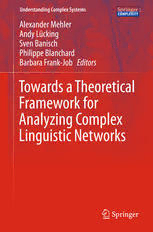Table Of ContentUnderstanding Complex Systems
Alexander Mehler
Andy Lücking
Sven Banisch
Philippe Blanchard
Barbara Frank-Job Editors
Towards a Theoretical
Framework for
Analyzing Complex
Linguistic Networks
Springer Complexity
SpringerComplexityisaninterdisciplinaryprogram publishingthebestresearchandacademic-
level teachingonbothfundamental andappliedaspects ofcomplexsystems—cutting across all
traditionaldisciplinesofthenaturalandlifesciences,engineering, economics,medicine,neuro-
science,socialandcomputerscience.
ComplexSystemsaresystemsthatcomprisemanyinteractingpartswiththeabilitytogenerate
anewqualityofmacroscopiccollectivebehaviorthemanifestationsofwhicharethespontaneous
formationofdistinctivetemporal,spatialorfunctionalstructures.Modelsofsuchsystemscanbe
successfullymappedontoquitediverse“real-life”situationsliketheclimate,thecoherentemis-
sion oflight from lasers, chemical reaction–diffusion systems, biological cellular networks, the
dynamicsofstockmarketsandoftheinternet,earthquakestatisticsandprediction,freewaytraffic,
thehumanbrain,ortheformationofopinionsinsocialsystems,tonamejustsomeofthepopular
applications.
Althoughtheirscopeandmethodologiesoverlapsomewhat,onecandistinguishthefollowing
mainconceptsandtools:self-organization,nonlineardynamics,synergetics,turbulence,dynami-
calsystems,catastrophes,instabilities,stochasticprocesses,chaos,graphsandnetworks,cellular
automata,adaptivesystems,geneticalgorithmsandcomputationalintelligence.
ThethreemajorbookpublicationplatformsoftheSpringerComplexityprogramarethemono-
graphseries“UnderstandingComplexSystems”focusingonthevariousapplicationsofcomplex-
ity,andthe“SpringerSeriesinSynergetics”,whichisdevotedtothequantitativetheoreticaland
methodologicalfoundations,andthe“SpringerBriefsinComplexity”whichareconciseandtopical
workingreports,case-studies,surveys,essaysandlecturenotesofrelevancetothefield.Inaddition
tothebooksinthesetwocoreseries,theprogramalsoincorporatesindividualtitlesrangingfrom
textbookstomajorreferenceworks.
EditorialandProgrammeAdvisoryBoard
HenryAbarbanel,InstituteforNonlinearScience,UniversityofCalifornia,SanDiego,USA
DanBraha,NewEnglandComplexSystems,InstituteandUniversityofMassachusetts,Dartmouth,USA
PéterÉrdi,CenterforComplexSystemsStudies,KalamazooCollege,USAandHungarianAcademyof
Sciences,Budapest,Hungary
KarlFriston,InstituteofCognitiveNeuroscience,UniversityCollegeLondon,London,UK
HermannHaken,CenterofSynergetics,UniversityofStuttgart,Stuttgart,Germany
Viktor Jirsa, Centre National de la Recherche Scientifique (CNRS), Université de la Méditerranée,
Marseille,France
JanuszKacprzyk,SystemResearch,PolishAcademyofSciences,Warsaw,Poland
KunihikoKaneko,ResearchCenterforComplexSystemsBiology,TheUniversityofTokyo,Tokyo,Japan
ScottKelso,CenterforComplexSystemsandBrainSciences,FloridaAtlanticUniversity,BocaRaton,
USA
Markus Kirkilionis, Mathematics Institute and Centre for Complex Systems, University ofWarwick,
Coventry,UK
JürgenKurths,NonlinearDynamicsGroup,UniversityofPotsdam,Potsdam,Germany
AndrzejNowak,DepartmentofPsychology,WarsawUniversity,Poland
HassanQudrat-Ullah,SchoolofAdministrativeStudies,YorkUniversity,Canada
LindaReichl,CenterforComplexQuantumSystems,UniversityofTexas,Austin,USA
PeterSchuster,TheoreticalChemistryandStructuralBiology,UniversityofVienna,Vienna,Austria
FrankSchweitzer,SystemDesign,ETHZürich,Zürich,Switzerland
DidierSornette,EntrepreneurialRisk,ETHZürich,Zürich,Switzerland
StefanThurner,SectionforScienceofComplexSystems,MedicalUniversityofVienna,Vienna,Austria
Understanding Complex Systems
Founding Editor: Scott Kelso
Futurescientificandtechnological developments inmanyfieldswillnecessarily dependuponcoming
togripswithcomplexsystems.Suchsystemsarecomplexinboththeircomposition—typically many
differentkindsofcomponentsinteractingsimultaneouslyandnonlinearlywitheachotherandtheirenvi-
ronmentsonmultiplelevels—andintherichdiversityofbehaviorofwhichtheyarecapable.
TheSpringerSeriesinUnderstandingComplexSystemsseries(UCS)promotesnewstrategiesand
paradigmsforunderstandingandrealizingapplicationsofcomplexsystemsresearchinawidevarietyof
fieldsandendeavors.UCSisexplicitlytransdisciplinary.Ithasthreemaingoals:First,toelaboratethe
concepts,methodsandtoolsofcomplexsystemsatalllevelsofdescriptionandinallscientificfields,
especiallynewlyemergingareaswithinthelife,social,behavioral,economic,neuro-andcognitivesci-
ences(andderivativesthereof);second,toencouragenovelapplicationsoftheseideasinvariousfields
ofengineeringandcomputationsuchasrobotics,nano-technology andinformatics;third,toprovidea
singleforumwithinwhichcommonalitiesanddifferencesintheworkingsofcomplexsystemsmaybe
discerned,henceleadingtodeeperinsightandunderstanding.
UCSwillpublishmonographs,lecturenotesandselectededitedcontributionsaimedatcommunicat-
ingnewfindingstoalargemultidisciplinaryaudience.
Moreinformationaboutthisseriesathttp://www.springer.com/series/5394
·
Alexander Mehler Andy Lücking
·
Sven Banisch Philippe Blanchard
Barbara Frank-Job
Editors
Towards a Theoretical
Framework for Analyzing
Complex Linguistic Networks
ABC
Editors
AlexanderMehler PhilippeBlanchard
Goethe-UniversityFrankfurtamMain DepartmentofPhysics
DepartmentofComputerScience UniversityofBielefeld
andMathematics Bielefeld
FrankfurtamMain Germany
Germany
BarbaraFrank-Job
AndyLücking FacultyofLinguistics&LiteraryStudies
Goethe-UniversityFrankfurtamMain UniversityofBielefeld
DepartmentofComputerScience Bielefeld
andMathematics Germany
FrankfurtamMain
Germany
SvenBanisch
MaxPlanckInstituteforMathematics
intheSciences
Inselstrasse22
D-04103Leipzig
Germany
ISSN1860-0832 ISSN1860-0840 (electronic)
UnderstandingComplexSystems
ISBN978-3-662-47237-8 ISBN978-3-662-47238-5 (eBook)
DOI10.1007/978-3-662-47238-5
LibraryofCongressControlNumber:2015940024
SpringerHeidelbergNewYorkDordrechtLondon
(cid:2)c Springer-VerlagBerlinHeidelberg2016
Thisworkissubjecttocopyright.AllrightsarereservedbythePublisher,whetherthewholeorpartof
thematerialisconcerned,specificallytherightsoftranslation,reprinting,reuseofillustrations,recitation,
broadcasting,reproductiononmicrofilmsorinanyotherphysicalway,andtransmissionorinformation
storageandretrieval,electronicadaptation,computersoftware,orbysimilarordissimilarmethodology
nowknownorhereafterdeveloped.
Theuseofgeneraldescriptivenames,registerednames,trademarks,servicemarks,etc.inthispublication
doesnotimply,evenintheabsenceofaspecificstatement,thatsuchnamesareexemptfromtherelevant
protectivelawsandregulationsandthereforefreeforgeneraluse.
Thepublisher,theauthorsandtheeditorsaresafetoassumethattheadviceandinformationinthisbook
arebelievedtobetrueandaccurateatthedateofpublication.Neitherthepublishernortheauthorsor
theeditorsgiveawarranty,expressorimplied,withrespecttothematerialcontainedhereinorforany
errorsoromissionsthatmayhavebeenmade.
Printedonacid-freepaper
Springer-VerlagGmbHBerlinHeidelbergispartofSpringerScience+BusinessMedia
(www.springer.com)
Introduction
AlexanderMehler,AndyLu¨cking,SvenBanisch,
PhilippeBlanchard,andBarbaraFrank-Job
1 Onthe Content ofThis Book
Currently,weobserveanadventofapproachestoanalyzinglinguisticnetworkswith
themethodsofstochasticphysicsandgraphtheory.Generallyspeaking,alinguis-
tic network is represented by a graph whose vertices denote linguistic units (e.g.,
words, sentences, or textual units) and whose edges modellinguistic (e.g. syntac-
tic,semanticorpragmatic)relationsoftheseunits.Theaimofmodelsoperatingon
such networks is to capture the synchronic, topologicalor evolutionary dynamics
oflinguisticsystems, say,onthephonological,morphological,syntactic,semantic
orpragmaticlevel.Whatthese approacheshaveincommonisthattheymodelthe
structuralor temporaldynamicsof linguistic systems in orderto test information-
theoreticalorlinguistichypothesesonthegroundsofcomplexnetworktheory.This
ispartlydoneintermsofastrongnetworkperspectiveaccordingtowhichthenet-
workapproachisseentobeindispensabletotestthefocalhypotheses.Apparently,
the area of language evolution provides a good test case for such an approach.
AlexanderMehler·AndyLu¨cking
Goethe-UniversityFrankfurtamMain,DepartmentofComputerScienceandMathematics,
FrankfurtamMain,Germany
e-mail:{Mehler,Luecking}@em.uni-frankfurt.de
SvenBanisch
MaxPlanckInstituteforMathematicsintheSciences,Inselstrasse22,
D-04103Leipzig,Germany
e-mail:[email protected]
PhilippeBlanchard
FacultyofPhysics,BielefeldUniversity,Germany
e-mail:[email protected]
BarbaraFrank-Job
FacultyofLinguistics&LiteraryStudies,UniversityofBielefeld,Bielefeld,Germany
e-mail:[email protected]
VI A.Mehleretal.
Language evolution can be seen as a meso system that connects language as a
macro system with the micro system of cognitive processes of language process-
ing.Startingfromsuch a unifiedapproachto languagestructure,languagechange
andprocessing,networkapproachestry to gaininsightsinto the lawsof linguistic
informationprocessingincommunitiesofsocialagents.
Inspiteoftheremarkablesuccessregardingthedevelopmentofexpressivegraph
modelsoflinguisticsystems,theseapproachesarestillinneedofaunifyingframe-
work.Todate,themodelsareconnectedbyacommonmethodicalstancebasedon
complexnetworktheoryinadditiontoquantitativelinguistics.Thus,wefacearange
of diverse network models that focus on laws of information processing without
clarifyingtheirsynergeticinterdependencies.Thisispartlyduetothelackofshared
standardsofdatamodeling,oftheinteroperabilityofalgorithmicgraphmodelsand
ofthesustainabilityoftheunderlyinglinguisticresourcesandcorpora.Obviously,
interdisciplinary research across the boarder of computer science, linguistics and
stochasticphysicsmayprofitfromtheavailabilityofsuchstandards.
This book aims at making first steps into the direction of filling this gap. It
presentstheoreticaland empiricalresultsin supportofa unifyingapproachto lin-
guistic networks that may help to overcome bottleneck problems of this field of
research.Tothisend,thebookcomprisesrecentresearcheffortsintheareaoflin-
guisticnetworks.Itbringstogetherscientistswithdiversebackgroundsrangingfrom
linguisticstotext-technology,fromcomputationalhumanitiestostatisticalnetwork
theory.The bookis organized,roughly,into six partsincludingsemanticand syn-
tactic networks, the interplay of language and cognition, the simulation of socio-
linguisticdynamicsandtext-technologicalresourcesofnetworkmodeling.Special
emphasisis putoncritical articlesand articlesthat reviewrecentdevelopmentsin
thefield.Thisincludesthefollowingfieldsofresearch:
(cid:129) Resourcesoflinguisticnetworkanalysis.
(cid:129) Principlesoflinguisticnetworkinduction.
(cid:129) Topologicalmodelsoflanguagestructure.
(cid:129) Modelsoflanguagedynamics:evolution,diachrony,change.
(cid:129) Unifiedmodelsfromstochasticphysics.
(cid:129) Networkmodelsfromcognitivelinguistics.
(cid:129) Networkmodelsofphonological,lexical,syntactic,semanticorpragmaticsys-
tems.
(cid:129) Networkmodelsoftextsystemsincontrasttolanguagesystems.
Dealingwiththeseandrelatedtopics,theaimofthebookistoadvocateandpromote
networkmodelsoflinguisticsystemsthatarebothbasedonthoroughmathematical
modelsandsubstantiatedintermsoflinguisticinterpretations.Inthisway,thebook
contributesfirststepstowardsestablishingastatisticalnetworktheoryasatheoret-
ical basis of linguistic network analysis across the boarderof the naturalsciences
andthehumanities.
Introduction VII
2 Overview oftheBook
2.1 PartI:Cognition
Successfulapplicationsofnetworkanalysiswithaparticularfocusontheinterplay
of language and cognition are reviewed in the chapter of Beckage and Colunga.
Concentratingonsemanticandphonologicalnetworks,itexploresnetworkfeatures
andtheirrelationtohumanlanguageperformanceincludingtheapplicationtocog-
nitiveimpairmentandatypicalbehavior.
The chapter by Vitevitch, Goldstein and Johnson combines network tools and
datafromapsycholinguisticexperimenttoexplorespeechperceptionerrorswiththe
aimtounderstandbetterwhatisperceivedwhenaspokenwordismisperceived.The
experimentalresultsoftheirphonologicalassociationtaskareevaluatedintermsof
path’onanetworkofphonologicalsimilarity.
The chapter by De Deyne, Verheyen and Storms compares semantic networks
derivedfromtextcorporawithnetworksobtainedthroughwordassociationexper-
iments by looking at macro- and mesoscopic properties of both types of graphs.
Whiletheanalysisrevealsstructuralsimilaritiesatthegloballevel,significantdif-
ferencesbetweentextandwordassociationgraphsemergeatalowerlevelofcom-
munitystructureorcentrality.Thechapteralsopresentsacomparisonwithhuman
relatednessjudgments.
2.2 PartII:Topology
The chapter by Biemann, Krumov, Roos and Weihe presents a statistical analysis
ofthemotifsignaturesofco-occurrencegraphsincludingco-authorshipnetworks,
communication networks and linguistic co-occurrence graphs of natural and arti-
ficial languages. Based on the hypothesis that different word classes serve differ-
entfunctionsinalanguageananalysisofco-occurrencegraphsfordifferentword
classes(verbsvs.nounsvs.adjectivesetc.)isperformedwhichshowsthatespecially
verbsaredistinguishablefromotherwordclassesbytheirmotifsignature–across
differentlanguages.
ThechapterbyArau´joandBanischhighlightstheneedtoconsiderdifferentways
ofnetworkinductioninnetwork-basedanalysisoflanguageandreasonsthatinduc-
tionandanalysisarestronglyinterdependenttasks.Basedonaframeworkcompris-
ing differentabstractionlevelsalongwith levelsof statistical analysis,the authors
arguethatthefieldoflinguisticnetworksischallengedbythefactthataninterpre-
tation of topological indicators used in network analysis becomes the harder, the
highertheabstractionlevelofthenetwork.
The chapter by Masucci, Kalampokis, Egu´ıluz and Herna´ndez-Garc´ıa presents
an information-theoretic approach to derive a directed network of semantic flow
between Wikipedia articles using a complete snapshot of the English Wikipedia.
Theauthorsshowthattheresultingsemanticspaceischaracterizedbyascale-free
behavior at differentscales which implies a hierarchicalorganization of semantic
spaces.
VIII A.Mehleretal.
The chapter by Zweig confronts the physically-inspired context-free quest for
universal structures with the need of contextual interpretations in sociology and
in linguistics. Zweigquestionsthe usefulnessof networkrepresentationsofword-
adjacencyrelations,becausemostofthewell-knowntopologicalindicatorsrelyona
ratherspecificnetworkprocessandtheymaythereforebemisleadingifthisprocess
isnotknownornotadequatelymodeledbytheprocessunderlyingthemethod.
2.3 PartIII:Syntax
ThechapterbyCˇech,MacˇutekandLiupresentsacriticalreviewoftheapplication
of complex network tools to the analysis of syntax and points out the main chal-
lengesforfurtherresearch.Amongmanyotherthings,thearticlediscussestheim-
pactofsyntaxonnetworkproperties,thepreprocessingofdata,andtheapplication
ofnetworkstudiestolanguagetypologyandacquisition.
A second chapter dealing with syntactic dependency networks is by Chen and
Liu.Basedontwosyntacticdependencynetworksfromdifferentgenresthischapter
analyses the syntactic status of three function words in Chinese. The importance
(the authors propose the notion of syntactic centrality) of the words is analyzed
byindependentlyremovingthemfromthe networkandcomparingtheirstatistical
characteristicsbeforeandafterremoval.
ThechapterbyFerreriCanchochallengestheexistingtheoryofsyntaxbycon-
fronting the observation that syntactic dependencies between the words of a sen-
tence rarely cross when drawn over a sentence with two null hypotheses for the
expected number of crossings by chance. Relying on the trade-off between parsi-
monyandexplanatorypower,thechapterarguesthattheminimizationofsyntactic
dependencylength(asaprinciplethatderivesfromlimitedcomputationalresources
ofthebrain)canexplainuncrossingdependenciesandthatthisexplanationis,from
aneconomicpointofview,preferableoverexplanationsrelyingongrammar.
2.4 PartIV:Dynamics
Theroleofculturaltransmissioninlanguagechangeacrossthreegenerationsisan-
alyzed on the basis of an extended simulation model by Gong and Shuai. While
transmissionwithintheoffspringgenerationandbetweentheoffspringandthepar-
entgenerationfosterslanguagechangeand leads, at the same time, to mutualun-
derstandability within generations and across consecutive generations, interaction
betweenchildrenandtheirgrandparent’sgenerationplaysanimportantroleinpre-
servingmutualcross-generationalunderstandabilityinthelongrun.
AnothersimulationstudyispresentedbyBaxterwhocomplementshisnumerical
resultswithanalyticalarguments.Drawingonanevolutionaryapproachtolanguage
change,theauthorlooksindetailtotheconvergencebehaviorofthemodelondif-
ferent social networks and with heterogeneous patterns of mutual influence that,
takentogether,mayencodeavarietyofsocialstructures.
Introduction IX
The chapter by Maity and Mukherjee presents a simulation study of the effect
ofinflexibleindividualsonthedynamicsofthenaminggameandshowsthatrigid
minoritieslead to the emergenceof dominantstates in the population.The model
isanalyzedonaseriesofstaticnetworksofdifferentcomplexityrangingfromthe
completegraphtoscale-freetopologiesandadynamicnetworkobtainedfromreal-
worldtime-varyingface-to-faceinteractiondataisalsoconsidered.
2.5 PartV:Resources
Therequirementsofadataformatapplicabletothewiderangeoflinguisticnetwork
dataarediscussedinthechapterbyStu¨hrenberg,DiewaldandGleim.Theauthors
analyzevariousexistinggraphformatsinrelationtotheirexpressivityandsupport
bycommontoolsfornetworkanalysisandproposeanextensionofGraphMLasa
possiblycomplexdatamodelofa graphwhichallowstoquicklyextractviewsfor
specifictasks,ratherthanextractingincoherentdifferentviewsfromrawdata.Itis
noteworthy,thatthischaptergrewoutofaworkinggroupthatwasconstitutedatthe
MLNconference.
ThebookconcludeswiththechapterbyMehlerandGleimwhopresenttheLN
system, an online platform for the automatic generation of lexical networks from
texts.Itaddressestwocommunities:ontheonehandhumanitiesscholars(e.g.,his-
toricalsemanticists)whoaimatstudyingthechangeoflanguageuseasanindicator
of social-semantic change. On the other hand, network theorists who are in need
ofnullmodelsformakinglinguisticnetworkscomparable.TheworkflowoftheLN
system–usingGraphMLasanoutputstandardforlinguisticnetworks–isexplained
andexemplified.

